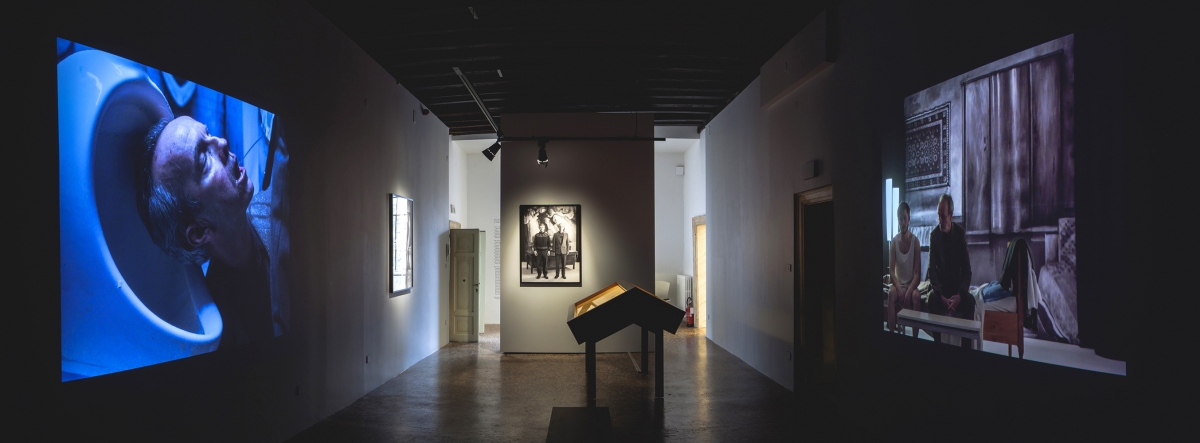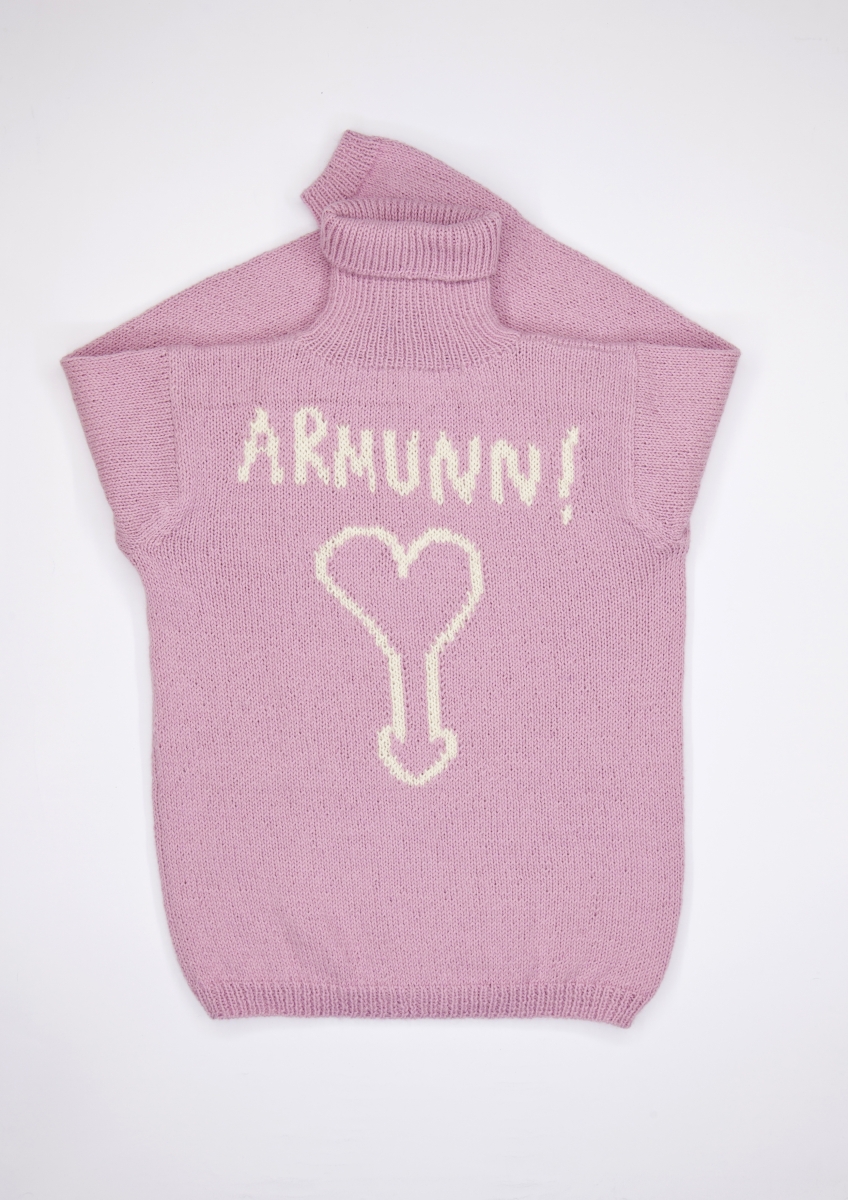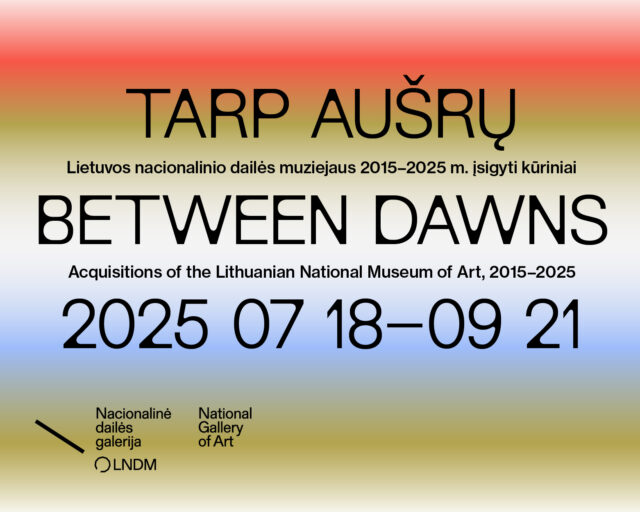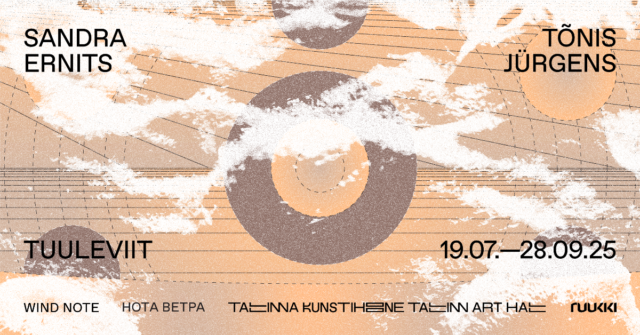
Jaanus Samma in the studio. Photo: Kristina Õllek
Jaanus Samma (b. 1982) is one of the hottest names on the Estonian contemporary art scene. His intelligent, appealingly sharp and always on-point method for commenting on various processes in society has brought him a lot of local and international appraisal. In 2015, he represented Estonia at the 56th Venice Biennale with his project NSFW. A Chairman’s Tale[1]. Prior to this in 2013, he won the Köler Prize[2], an annual award given to young, prestigious emerging artists by the Contemporary Art Museum of Estonia. Samma is represented by Temnikova&Kasela[3], one of the most successful commercial galleries in Tallinn today.
Samma has worked in photography, with installation, video and other alternative methods including knitwear and embroidery to explore gender studies, especially concentrating on representations of male sexuality, contemplating ways of portraying his subjects with his artistic means.
We met for an interview with Jaanus in his cosy studio in Tallinn Old Town to discuss his working methods, future plans and the social situations in today’s hectic world.
HELEN MERILA: How are you? I read that Nomas Foundation[4] in Rome has offered you a residency to work on a site-specific project curated by Eugenio Viola. Could you talk about that a little bit more?
JAANUS SAMMA: I have several projects on the go at the moment. In January there will be an exhibition at Temnikova & Kasela Gallery with part of the same exhibition probably traveling to a show in Rome. This project will be quite cognitive and only partly site-specific. I tried to explore the gay life in Rome, but it was quite complicated to dig thoroughly into the theme as I was only in residence there for a month. I try to avoid this kind of attitude of just slightly relating to a topic and then making something much deeper out of it as a conclusion. One or two months is obviously too little an amount of time to get to know the subject thoroughly enough. So I decided to use the fragments I found in the city and make something new out of them. That project is a bit related to cruising and some popular gay meeting spots.
HM: The Estonian pavilion at the Venice Biennale gained a lot of positive international attention last year. How has your life changed after participating at the Biennale? Have you had to neglect any offers due to a busier schedule?
JS: The Estonian pavilion was definitely not the most important pavilion in Venice, so there hasn’t really been that much of a storm after it. Although, I have had quite a number of exhibition offers since, but these often do not lead anywhere. So I’ve learned to be more critical before taking any action further, and to weigh each offer beforehand to see if there is any real potential for collaboration. Of course some proposals are very interesting; for example, the Nomas Foundation residency was organised by Eugenio Viola with whom I have continued to collaborate with since my participation at the Biennale and who has searched out these further possibilities for me. Mostly, I am interested in seeing my work travel to different places.
HM: So how is NSFW. A Chairman’s Tale doing? Where is it now?
JS: It has been divided between different collections. The Loge (2013) went to Riga, other videos and showcase have gone to Kiasma[5] (Helsinki) so I doubt that the installation will ever be displayed in its original version again. However, Kiasma is planning to do a Baltic exhibition in 2019 where A Chairman’s Tale (2013) could potentially show alongside The Bronze Soldier[6] (2009) (the infamous sculpture by Estonian artist Kristiina Normann that created a polemic because of its relation to local politics and sensitive matters) and I quite like this idea as I can actually see some connections between A Chairman’s Tale and the previous Estonian pavilions.

NSFW. A Chairman’s Tale, exhibition view, The Museum of Occupations, 2016. Photo: Anna-Stina Treumund
HM: With A Chairman’s Tale you explored topics of authoritarianism and human rights during the Soviet era. Did you have any specific memories about those times or were you trying to reconstruct this topic as something distant and abstract to you, seeing as you must have still been quite young during the Soviet occupation?
JS: I was born in 1982, so I have a vague memory of this period. For my parents’ generation it was normal life, and they did not think about how horrible the Soviet regime was every day. It was just a different kind of system which, for me as a kid, did not seem terribly bad as childhood is almost always a happy time anyway. For sure, my starting point with this project was a little different from Eugenio’s as he doesn’t have the same kind of cultural background as mine. I related to the theme quite quickly as I have some kind of elementary knowledge of life during the Soviet period. Besides, I have always been interested in history. As my parents were politically active, we went to the Baltic Chain[7] event and the Estonian Song Festivals[8] which were all quite exciting for me as a kid.
The importance of those times came back to me recently when I was looking through old newspapers while gathering stories. The nineties were mystical times in many ways, as anything seemed (and actually was) possible; the society was very open only because it was curious and did not yet have such rigid, settled opinions yet about minorities, neither was there much awareness about these topics. Advertisements for gay parties and sex parties were even published in the newspapers as explorations of sexuality were becoming more popular. Today it has somehow disappeared again, so we can basically talk about the second wave of conservatism. But the ‘gay life’ here wasn’t so different from Western Europe and in some aspects, they were quite alike.
HM: It has been said that your work is quite an intelligent social commentary. Is your Foucauldian-like method of being extremely thorough in research before opening new pages somehow linked to your family background of academics?
JS: My grandfather was an editor/translator and my father is a historian, but neither are or were actual academics. So perhaps there is some link between my work and a certain cultural background but I don’t know if this is the reason for me being thorough like you say. I just think that in this field, everybody tries to be thorough. A Chairman’s Tale is very sensitive as a subject and there are many danger zones where it would be easy to slip up without researching sufficient information.
HM: Have you left any projects unfinished due to a lack of sufficient information?
JS: The Rome project has to be resolved some other way, so with this I’m not aspiring for any kind of absolute truth, but rather showing the issue(s) more playfully from my own position. And there are some other projects on hold, waiting for the right moment which are developing on their own.
HM: The Nomas Foundation website says that in general, an artist’s point of view regarding the global, political and cultural processes becomes relevant because they are privileged observers of social phenomena. What do you think about this definition. Would you agree?
JS: Of course in some moments you realise that you’re an outside observer, just like in A Chairman´s Tale. It becomes quite a comfortable position to rate or analyse the issue retrospectively when not that many of us would know what to have done under those circumstances. Even speaking in general about one’s Soviet background, about who was red and who wasn’t, I cannot say whether I would have hidden a blue, black and white flag (the Estonian national flag) under my bed forever. In that perspective, the outsider’s privileged position shouldn’t be forgotten
HM: Did you notice A Chairman´s Tale taking on any new perspectives from the international audience it received in Venice? Were they surprised about the way things were during the Soviet Union?
JS: It is difficult to say. Working on the project together with Eugenio, I realised what the common stereotype about Soviet Union is from an outsider’s point of view. But actually it was even more interesting talking to Estonian audiences who lived through that period but weren’t necessarily aware of the layers in the society – what kind of lives these people lived or which problems they had despite living side by side with one another. I showed them that layer of life in a little bit of a grotesque way as I felt that I did not want people to feel too comfortable walking through the exhibition when exploring this delicate topic. I wanted the audience to feel the gravitas of the theme and felt that people needed to be shaken up a little bit, but without being shocking for shock’s sake. So yes, it was a conscious decision on my part to show things more vividly, and to turn up the volume.
HM: On the one hand, it would seem like Estonia’s image on human rights is rather positive internationally, with the so-called ‘gay marriage law enactment’ and choosing A Chairman´s Tale to represent their country at the Venice Biennale. On the other hand, I have found a call for action protesting against your exhibition opening in the Occupations´ Museum here in Tallinn from a group of patriotically-minded heterosexual men on the web page for Nõmme Radio (a local independent radio station). Did this protest ever actually happen?
JS: Fortunately for me, there was an EKRE (Conservative People’s Party of Estonia) gathering in the neighbouring building at the same time, so I think all these guys went there. But since we had Eiki Nestor at the opening, the Estonian Speaker of Parliament, we had to have security present. So the opening turned into some kind of a performance with about nine security guys dotted around, and people who came to the opening probably had a bit of an ambivalent impression about the whole thing. But on the other hand, maybe it drew in more attention to the subject as this had never happened before. For sure it had a lot to do with the location; if it had taken place in KUMU (the biggest filiale of Estonian museums of art) there wouldn’t have been such a problem.
It is difficult to answer this question today as there is so much going on lately in the world that makes me think that maybe the situation here isn’t so bad at all. We don’t know what will happen during the next elections in France with Marine Le Pen gaining popularity and so on. It isn’t scary to see that in Estonia the conservatives have about eight-to-nine votes in Parliament, but it is scary to think that a while ago they weren’t present at all, and now they have formed 10%, more or less. When it comes to certain processes in society, you just have to wait for the outcomes and see where they are heading, or perhaps take further action rather than waiting, as apparently the problems haven’t disappeared at all.
In Estonia, even the co-habitation law has not yet been enacted, meaning perhaps it will all be cancelled. When monitoring the processes in the world today, Brexit, Trump etc., I realised that, although my friends all over the world are surprised about these developments, it seemed we all lived in some kind of bubble which was and is rather distant from these other societal groups. If I said that I haven’t personally faced any negative experiences here in Estonia, it is true, but I wouldn’t make it a dogma because I just haven’t been in an area or a place where I’ve had to contact with such people who think so vehemently different.

Estonian pavillion at the 56th Venice Biennale. NSFW. A Chairman’s Tale, exhibition view, 2015. Photo: Reimo Võsa-Tangso
HM: This leads me exactly to my next question: As an artist who comments on sensible topics in society, how do you relate to the complexities of human rights processes taking place around the world right now?
JS: I certainly see myself as more of an artist than an activist, but I am connected with some other fields. For example, we organised a Soviet and Socialist LGBT Histories Conference in September. It was interesting to note that quite a number of academics took interest in it. With the same subject, we are also going to a conference in Paris which, due to a large number of applicants, many could not be invited. I am standing with one foot in the interdisciplinary world, and I am not the only artist there. From Poland there is also Karol Radziszewski, and Yevgeniy Fiks is a Russian artist from New York. Both deal with similar topics. Karol has concentrated on the gay history of Eastern Europe and has admitted that certain artists reached these issues in their work prior to the scientific groups and community following their trends. He has also stated that sometimes the results of these artists are more courageous and therefore more interesting. It was really inspiring for me to hear that.
HM: So can it be said that all your pieces are connected through this kind of intelligent rebelliousness?
JS: Yes, I think it can be said. I like to play with contrasts and to offer some kind of pleasure from one side, and the cool it down from the other side. A Chairman’s Tale was also a beautiful piece – the loge and the showcase – but on the other hand the theme was so grotesque that it balanced out this beauty. I never want an exhibition to become too sticky sweet.
HM: In the past, you have collaborated with professional artists from different fields. With whom might you be planning or wishing to collaborate with in the future?
JS: Ideas about collaboration between artists and literary scholars have developed from these conferences as we have found some very interesting issues in Latvia, for example. So maybe in the future something will come out of this.
HM: You aren’t loyal to just one medium. Lately you have mentioned being interested in making jewellery. Can this desire also somehow be linked to your new project?
JS: I have indeed done some experiments, but right now it is too early to speak about them. I think my interest in jewellery is linked to the fact that quite a large number of neighbours in my studio are jewellers.
HM: But what about these pieces on the floor? (There are some little white ceramic figures lying on the studio floor, seemingly cupboard knobs or something similar)
JS: They are actually toilet pulls. These are linked to my new exhibition which partly has to do with public toilets being a popular meeting place for gay people. It started in Rome where I observed these marginal spaces being appropriated by marginal groups. In general, I find public toilets to be an interesting phenomenon – they are most usually located somewhere central in every city, but some of the most extreme things go on in there under the eyes of the authorities; for example in China, it has become a meeting place for men to sit and read newspapers while discussing politics which, as we know about the political life in China being heavily censored, can grant a kind of total freedom in a country where the conditions offer very little freedom. For the authorities, public toilets seem to be less considerable, making them these kind of ‘non-places’.

Jaanus Samma. Posters. Kilometre of Sculpture, Rakvere, 2016. Photo Jaanus Samma
HM: Where do you usually store your art?
JS: My first solo exhibition was really successful and I sold all the pieces. Then there was a longer break for about ten years when I didn’t sell anything at all, which was also great as I did not think about selling when making the exhibitions. One of the great bonuses about being an artist in Estonia is that you don’t have to be worried about making sellable art. You have the freedom to just create what you like without having to think about the market at all because there just isn’t a market like there is in other places.
Now I have been selling the Biennale pieces, which is also great as before, I wouldn´t have known where to store their bigger parts. After winning the Köler Prize, I rented a storage space as I did not yet know whether my work would be selected for Venice. I also now collaborate with Temnikova&Kasela Gallery who have a storage space where I can keep my work, and of course I have my own studio. As all the artists share this problem, it would be great to have a rental space in square meters for the artists, which ARS[9] are currently working on right now.
HM: Have you still got any pieces left from the Hair Sucks sweater collection[10]? I´ve heard that these all sold out really quickly during the NADA Miami Beach art fair? I saw a number of prominent art world people posting pictures on social media wearing your knitted works with these provocative and eye-catching graffiti messages across them.
JS: Yes, a lot of my sweaters sold in Miami because it is easier to sell pop-art motives in the US than it is in Basel, for example. But I’ve still got some sweaters and there will be more to come; it is an ongoing process. Next year, I will have an exhibition in Tornio, Northern Finland – the spot where Sweden and Finland meet near the top of the gulf. It will partly be a site-specific exhibition as I am going to use locally-produced wool that’s been coloured with herbs. But as there is no graffiti in Tornio, I will have to find these images from elsewhere.
I have kept a couple of sweaters for myself, and then there is one that is left probably because its text was written in Estonian. (Jaanus shows me a pretty, baby-rose sweater carrying a graffiti with a dick drawn on and Estonian writing ARMUNN which is a weird word play uniting the words ‘in love’ and ‘dick’. I am extremely fascinated by these sweaters which I’ve coveted for years but am too intimidated to ask whether it’s for sale and, alas, sadly witness it slipping back into his bag).
HM: A Chairman’s Tale is also a tale about opera. What is your relationship with music?
JS: I mostly listen to classical music. When it comes to opera, I like everything else that surrounds it more than the music. I chose opera because it is such an absurd, funny and multi-faceted genre. I used to only listen to the synopses of operas on Classical radio broadcasts, as these were weirdly presented in an academic manner which I found really bizarre since their plots usually reminded me more of a messy Venezuelan TV series!
HM: You have said in the past that you represented ‘yourself’ in Venice and not Estonia. Yet, you have also admitted to looking at certain exhibitions in the Biennale as being states and others as artists´ projects..?
JS: Unfortunately only bigger countries usually have well-known names but if you were to visit the Cyprus pavilion, for example, and you didn’t know any artists from this country previously, then this is the only link you’d have there with that country’s art. I must admit though, that I did not think that much about what kind of impression my work would make for Estonia as a state. For me, it was more important to hear feedback about Estonia having the courage to come out with this kind of project more than anything else. I never thought that this could be an issue because the art committee in Estonia made these decisions. I had some feedback though from an acquaintance of a friend who’d visited the exhibition that this was not his Estonia which A Chairman’s Tale represented. So after all, basically you represent yourself anyway.
HM: There is a huge cultural divide in the country – one side being proud of A Chairman’s Tale representing Estonia, and the other side denying and opposing it. It is probably a million-dollar question but do you think there is anything that could be done to bring these different sides closer to each other?
JS: It helps to think open-mindedly; understanding and being aware of the other kind. It is also a broader educational problem where the number of visitors to museums has got really low. There hasn’t really been that much done about it although Tallinn Art Hall and KUMU have started to work on their public programming. Yet before KUMU, the situation was even worse (KUMU was opened in 2006 – H.M). Today many people have visited it in order to at least see the building. KUMU has been also quite successful involving the Russian audience with its several exhibitions but on the other hand it is shameful and absurd that Russian is not the third language in KUMU; there are just Estonian and English titles in the permanent exposition. For example in Kiasma (Helsinki) there are four languages displayed everywhere: Finnish, Sweden, English and Russian. These are small but highly meaningful things that could be done for one ethnical group to feel welcome.
HM: Jaanus, it’s been a pleasure to interview you, many thanks!
JS: Thank you!

Jaanus Samma, Armunn, sweater, 2014. Photo: Anu Vahtra
Jaanus Samma´s solo-exhibition “Divider”
Temnikova&Kasela Gallery, Tallinn
January 21 – March 11, 2017
[1] http://www.jaanussamma.eu/nsfw-a-chairmans-tale/
[2] http://www.ekkm.ee/jaanus-samma-to-represent-estonia-at-the-venice-biennale-in-2015/
[3] http://www.temnikova.ee/
[4] http://www.nomasfoundation.com/en/residenze/jaanus-samma/
[5] http://www.kiasma.fi/
[6] http://www.kristinanorman.ee/after-war/
[7] https://en.wikipedia.org/wiki/Baltic_Way
[8] https://en.wikipedia.org/wiki/Estonian_Song_Festival
[9] ARS is a property belonging to Estonian Artists’ Association which aim is to develop an unique environment where creation, tradition and marketing meet in one campus.
[10] http://www.jaanussamma.eu/sweaters/






























